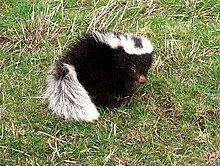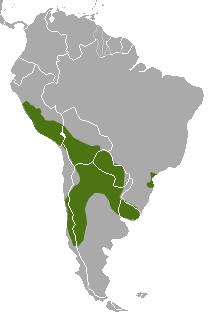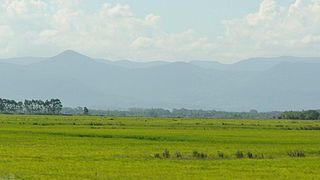
The Pampas are fertile South American low grasslands that cover more than 1,200,000 square kilometres (460,000 sq mi) and include the Argentine provinces of Buenos Aires, La Pampa, Santa Fe, Entre Ríos, and Córdoba; all of Uruguay; and Brazil's southernmost state, Rio Grande do Sul. The vast plains are a natural region, interrupted only by the low Ventana and Tandil hills, near Bahía Blanca and Tandil (Argentina), with a height of 1,300 m (4,265 ft) and 500 m (1,640 ft), respectively.

The maned wolf is a large canine of South America. It is found in Argentina, Brazil, Bolivia, Peru, and Paraguay, and is almost extinct in Uruguay. Its markings resemble those of foxes, but it is neither a fox nor a wolf. It is the only species in the genus Chrysocyon.

The Pampas fox, also known as grey pampean fox, Pampas zorro, Azara's fox, or Azara's zorro, is a medium-sized zorro, or "false" fox, native to the South American Pampas. Azara in some of its alternative common names is a reference to Spanish naturalist Félix de Azara.
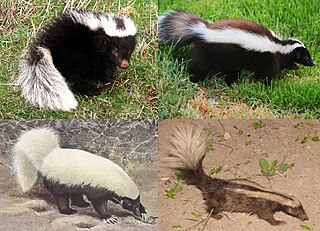
The hog-nosed skunks belong to the genus Conepatus and are members of the family Mephitidae (skunks). They are native to the Americas. They have white backs and tails and black underparts.

The Pampas deer is a species of deer that live in the grasslands of South America at low elevations. They are known as veado-campeiro in Portuguese and as venado or gama in Spanish. It is the only species in the genus Ozotoceros.

The striped hog-nosed skunk is a skunk species from Central and South America. This species of skunk is considered a generalist species, because they are able to thrive in, and withstand, disturbed environmental conditions. They can live in a wide range of habitats, including carrasco, arboreal caatinga, mango orchard, and dry forest scrub and occasionally, in rainforest.
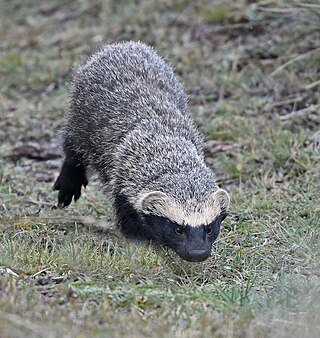
The lesser grison is a species of mustelid from South America.

The Chaco eagle or crowned solitary eagle, is an endangered bird of prey from eastern and central South America. Typically it is known simply as the crowned eagle which leads to potential confusion with the African Stephanoaetus coronatus. Due to its rarity, not much is known about its biology or population.

The Pampas cat is a small wild cat native to South America. It is listed as Near Threatened on the IUCN Red List as habitat conversion and destruction may cause the population to decline in the future.
The Pantanal cat is a Pampas cat subspecies, a small wild cat native to South America. It is named after the Pantanal wetlands in central South America, where it inhabits mainly grassland, shrubland, savannas and deciduous forests.
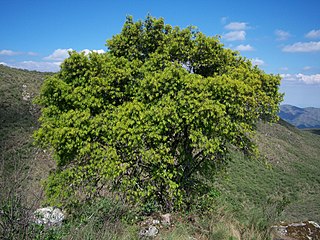
Podocarpus parlatorei is a species of tree in the family Podocarpaceae and native to Argentina and Bolivia, where it grows on steep hillsides on the eastern flanks of the Andes. It has been harvested commercially in the past but is now protected under CITES. The International Union for Conservation of Nature has assessed its status as being "near threatened".
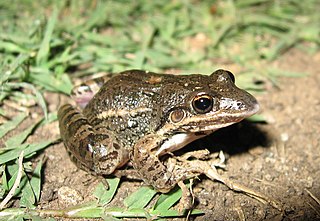
Leptodactylus latinasus is a species of frog in the family Leptodactylidae. It is found in the Gran Chaco of northern Argentina, Bolivia, and Paraguay and east and south to southern Brazil and Uruguay. Its natural habitats are subtropical or tropical grasslands near waterbodies. It tolerates anthropogenic disturbance well. It breeds in underground chambers. This abundant and adaptable species is not facing any important threats.

Humboldt's hog-nosed skunk, also known as the Patagonian hog-nosed skunk, is a species of hog-nosed skunk indigenous to the open grassy areas in the Patagonian regions of South Argentina and Chile. It belongs to the order Carnivora and the family Mephitidae.
Molina or La Molina may refer to:

The American hog-nosed skunk is a species of hog-nosed skunk from Central and North America, and is one of the largest skunks in the world, growing to lengths of up to 2.7 feet (82 cm). Recent work has concluded the western hog-nosed skunk is the same species, and Conepatus leuconotus is the correct name of the merged populations.
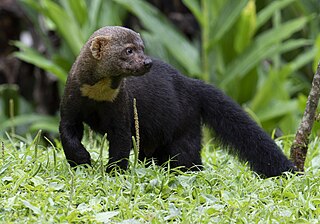
The tayra is an omnivorous animal from the weasel family, native to the Americas. It is the only species in the genus Eira.

Valgipes is an extinct genus of scelidotheriid ground sloth, endemic to intertropical Brazil and Uruguay during the Late Pleistocene. Thought to have been a forest-dwelling browser, Valgipes is a monotypic genus with a complex and long taxonomic history, and is a close relative of Catonyx and Proscelidodon.
